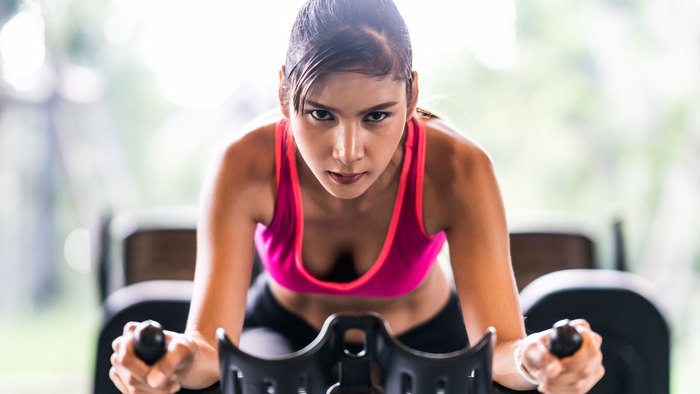Blog »
Do these workouts to go faster
Published 27 November 2019. Written by Chris Worfolk.

Last week, I wrote about the four factors that determine how fast you go: vo2 max, lactate threshold, economy and resilience. This week, I am going to continue this theme by talking about what we can do to improve each area.
Lactate threshold
Your lactate threshold is the point at which lactic acid begins to build up in your body faster than you can clear it out. This means that once we cross this threshold, it is only a matter of time until we need to stop.
The easiest way to get an estimate of your lactate threshold is to use a sports watch that provides that estimate for you.
The key to improving your threshold is to ride at or just above your current threshold. Typically, you can do this with steady-state intervals: working for 10 minutes at your threshold and then recovering. As you go on, you can increase these intervals to 20 or 30 minutes, if you like.
This isn't all-out efforts. We're aiming for comparatively long intervals that we can recover from in a reasonable amount of time. You are aiming for around a 7 out of 10 for perceived exertion. In running terms, this means around your half marathon pace, with 10k pace being the absolute maximum.
vo2 max
Improvements to your vo2 max happen above your lactate threshold. This means doing shorter, harder intervals. Aim for an 8-9 out of 10 on the perceived exertion scale.
In running terms, a typical interval may be anywhere from 2-5 minutes. For cycling and swimming, these intervals can be slightly longer: possibly up to 6-7 minutes.
You can also combine your vo2 max and lactate threshold work by doing an under/over workout. This means doing intervals that involve short periods above your threshold (say 30 seconds) with 3-4 minutes just below your threshold following it.

Economy
Economy is one of the best areas to make improvements as it has a smaller genetic component than the first two. We improve our economy by doing drills and cross-training.
The fundamentals of sport are sometimes referred to as the ABCs: agility, balance, coordination. If you can improve these, you are likely to become a more economical athlete.
Let's start with running. One of the things that set Kipchoge apart is his running economy. There is no wasted energy. He keeps his hips high and level. He runs upright. He has a quick turnover, low ground contact time and uses his arms to keep him moving forward.
Compare that to many of the people at the end of a marathon. They run slumped over in a shuffle, swaying from side-to-side with every step. Every sway is energy wasted because it is not propelling them forward.
There are multiple running drills we can do:
- Foot rolling
- Functional balance
- Cadence counting
- Lunges
Doing strength work in the gym, and anything that improves balance, such as yoga, will also help us remain strong and steady throughout our runs.
Improving your cycling economy works in several ways. First, balance and coordination are still important. If you watch the pros in a time trial, the best TT riders are still on their bikes while the non-TT specialists tend to rock from side to side and squirm around on their saddle.
Second, the most significant factor in cycling is aerodynamics. If you can hold the aero position for the whole race, you are going to go a lot faster than someone who cannot. Make sure you do your training on the aero bars if that is how you plan to race.
Finally, consider that cornering and descending are part of economy, too. There is no use in having the best vo2 max if you are always comfort breaking down hills and having to slow right down for corners.
Finally, improving your swimming economy. This is the big one: swimming is all about technique. If you can move through the water efficiently, you will crush someone who has a far bigger engine but terrible technique.
Improving your swimming comes down to drills. Every session in the pool should start with some drills. Then embed those skills in with some full stroke.
Resilience
The final factor in determining your speed is mental toughness. It is being able to work at a high intensity during a race and ignore that voice that is telling you to stop and take a rest.
Like economy, resilience is a good one to work on, because it is something that you can learn more than something you inherit genetically.
In our sport psychology course, we talk about a lot of different ways to improve your resilience, including:
- Systematic confidence building
- Self-talk
- Mindfulness
- Adversity training
- Mental imagery
Conclusion
A lot of new athletes go out and train without a plan. They go swimming, cycling or running regularly and hope to get faster.
This works, and there is nothing wrong with that. But if you want to get faster more quickly, or continue to make gains over time, you need to do specific workouts to target specific areas. Focussing a workout improves the efficiency with which you will improve.
This is one of the reasons that training plans and coaching can be useful: it is someone else's job to worry about providing sessions that provide a mix of improving all of these critical areas. However, if you are self-coached, all it takes is a quick consideration of what area each workout will target and modifying it appropriately. And make sure you are doing the drills and cross-training as appropriate.